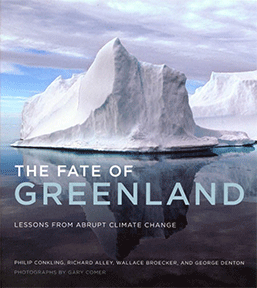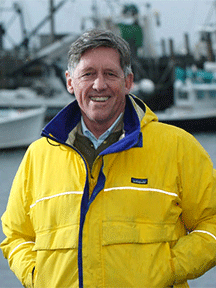
By Tea Fani
The Fate of Greenland: Lessons From Abrupt Climate Change (MIT Press 2011), by Philip Conkling, president of the Island Institute, and co-authors Richard Alley, Wallace Broecker, and George Denton, has been awarded the 2012 Phi Beta Kappa Science Book Award. This award, established by the Phi Beta Kappa Society in 1959, is offered to honor outstanding scientific contributions and to encourage literate and scholarly interpretations of the physical and biological sciences and mathematics.
The Fate of Greenland: Lessons From Abrupt Climate Change is a vivid and grippingly informative account of the several climate shifts Greenland has experienced in past centuries. Complete with breath-taking photographs of the snow-covered island, this book discusses what the current global warming period means for the future of Greenland and of the world.
Extending over 600,000 square miles, Greenland’s ice sheet is the largest outside Antarctica and is melting at a rapid rate. Using clues from Greenland’s climatic history as well as extensive research, the authors predict abrupt climate changes in Greenland will initiate immediate worldwide shifts in weather.
The world is currently in period of climate instability, only worsened by incessant and excessive greenhouse gas emissions. The melting of Greenland’s ice shelves would increase sea levels by twenty-four feet worldwide, putting coastal cities in grave danger from flash floods. Abrupt climate change would also institute desertification and storm patterns that will destroy economies and food supplies worldwide. The Fate of Greenland warns readers to pay close attention to Greenland and begin to take action on carbon dioxide emissions.
INTERVIEW
How did you come together with Richard Alley, Wallace Broecker, and George Denton to produce this study of Greenland? How did each author contribute to the creation of the book?
How did Greenland recover from the dramatic increase in temperature it experienced in the 10th century? Is the current global warming period similar to the Medieval Warm Period?
CONKLING: Changes in Earth’s climate have to do with climate feedback systems. One of the most important feedbacks in the Northern Hemisphere is sea ice. Sea ice reflects sunlight back into the atmosphere, keeping the temperature of the ocean water low by preventing the sun’s heat from warming the water. As the sea ice melts, however, the sunlight is absorbed into the ocean and increases the temperature of the water. Ocean currents eventually circulate the warmth throughout the oceans of the world. When sea ice melts rapidly, the climate can abruptly shift into a warm period. These are giant events that affect the entire globe.
What distinguishes the Medieval Warm Period from the modern warming we have experienced is that it was more of a local event, affecting only the North Atlantic. This period of increased temperatures made Greenland habitable, allowing the Norse to settle there. It is quite clear from historical trading records that sea ice was increasing at the end of the Medieval Warm Period. Over only a few decades, the expansion of sea ice made it impossible for ships to get to the isolated communities of Greenland, essentially cutting off trade and the circulation of critical supplies. This marked the end of the medieval warming and the beginning of the Little Ice Age. This change was the result of a relatively small feedback system. Sea ice crept in from the north and created a much cooler climate on both sides of the North Atlantic. Since there is no evidence of the Little Ice Age in the Southern Hemisphere, it does not appear to have been a global phenomenon.
Are human activities or natural variations in climate more responsible for the climate change being observed today?
CONKLING: The vast majority of scientists have stated, with almost overwhelming certainty, that humans are currently the dominant cause of climate change. The burning of fossil fuels and the loading of carbon dioxide into the atmosphere creates a feedback loop that will increasingly warm the planet.
Research by the Comer Fellows Program and a great deal of other scientific discoveries indicate that every time there has been an increase in global temperature there has also been an increase in carbon dioxide levels in the atmosphere. Conversely, every time the global temperature cools, there is a decrease in carbon dioxide. Virtually nobody disagrees with this strong correlation. However, a big question remains: Does carbon dioxide lead to temperature increase or does the temperature increase cause changes that release more carbon dioxide into the atmosphere?
The most recent scientific evidence indicates that carbon dioxide follows temperature increases. In the absence of anthropogenic causes, the Sun’s activity and the Earth’s natural orbital dynamics cause gradual increases in global temperature which, in turn, lead to carbon dioxide increases in the atmosphere, most likely from venting of the deep ocean where the carbon dioxide has been stored. As a result, carbon dioxide becomes part of a global feedback pattern. The more carbon dioxide released from the ocean and into the atmosphere, the more it traps heat. This will further increase the global temperature, cause more ice to melt, and contribute to more carbon dioxide emission, and so on. If carbon dioxide is such an important part of a climate feedback loop, the question is what happens when we double the amount of CO2 in the atmosphere as we are currently underway in doing? There is almost no question that the first and earliest affect will be the disappearance of sea ice.
What was the most surprising discovery you made through your research?
CONKLING: Through an extensive network of scientific field researchers who are studying climate change in a variety of contexts, it is increasingly apparent that there is an interconnected global climate system. This is the fundamental lesson of all ecology and is a deeply spiritual notion as well. Everything is connected. Looking at the entire planet as a single system is both wondrous and profoundly disturbing because it emphasizes that each individual’s activity has a global impact.
All of us were taught in high school that geologic changes happen so gradually and incrementally that they are nearly impossible to detect. The Earth naturally moves into warm and cold phases based on orbital dynamics. Over time, the wobble of the Earth, the tilt of its axis, and its varying proximity to the Sun build up tiny changes to the climate. However, Greenland’s ice cores and other geological data indicate that the warming and cooling of the Earth are not driven exclusively by slow, incremental changes. While the climate gets gradually warmer and cooler over thousands of years, a significant percentage of the warming occurs over a very short period of time (10-100s of years). Once a certain threshold is reached, climate change happens very fast. Scientists are still unsure of when that threshold will be reached.
Carbon dioxide, which intensifies and speeds up global warming, has been building up in the atmosphere more rapidly than ever. The carbon dioxide concentration in 1850 was 280 parts per million. Today, it is 394 parts per million. Scientists predict that this figure will soon double to 560 parts per million. This exponential increase in carbon dioxide emission is undoubtedly bringing us closer to that threshold point and to the possibility of abrupt climate change.
You mention that there is still some uncertainty as to how much warming will take place in future years, but that there will likely be a greater amount if people persist with the current level of greenhouse gas emissions. What can we do right now, individually, as a country, and as a global community, to slow climate change and make a real difference?
CONKLING: Since it is difficult to predict when the climate will abruptly shift, it is important that we have policies in place to prevent or delay its disastrous consequences. State-level leadership and policies drive large-scale change and are able to significantly reduce carbon dioxide emissions. One effective policy, employed by Austria and Denmark, is to institute a carbon tax. If businesses are able to externalize their costs so that the public bears the burden, they will never voluntarily change their behavior. Such a tax would allow carbon dioxide emission but require each business to pay for the harm they inflict upon the public. This will reduce the incentive to emit excessive amounts of carbon dioxide into the atmosphere. Similar taxes on sulfur dioxide emissions have caused a very rapid decrease in the amount of sulfur dioxide in the air.
That being said, the changes each individual can make in their lifestyle are not insignificant. It is important that people take the initiative to educate themselves on how they can reduce their carbon footprint.




